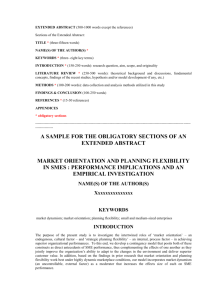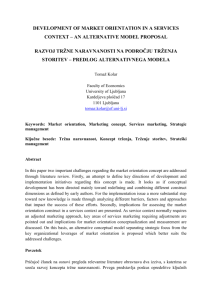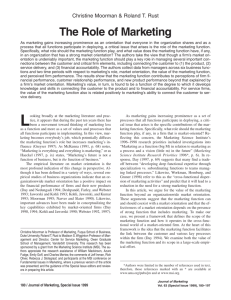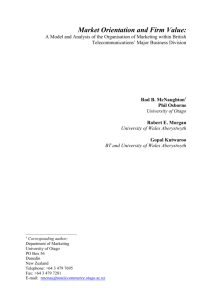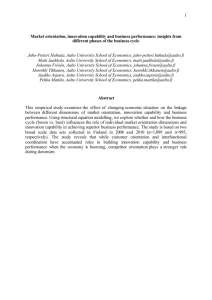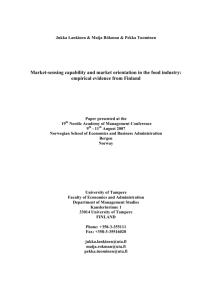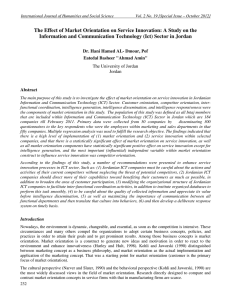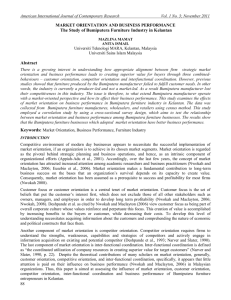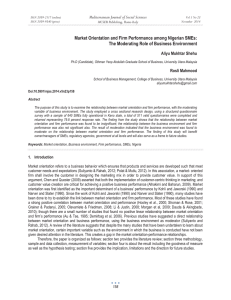Conceptualizing Effect of Market Orientation on Channel Strategy
advertisement
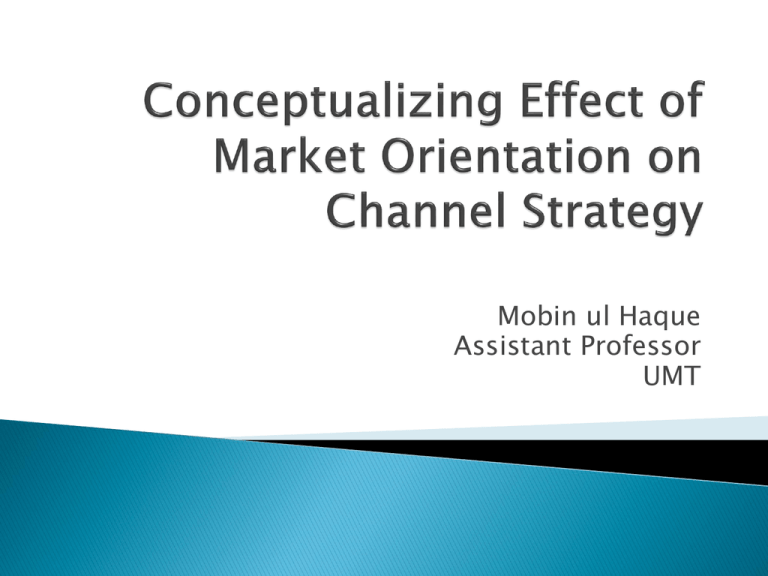
Mobin ul Haque Assistant Professor UMT Literature of marketing argues that success of a firm depends upon the extent to which it adopts marketing concept (Kohli and Jaworski 1990; Narver and Slater 1990; Farrell and Oczkowski 1997; Ngai and Ellis 1998; 2008). Mcnamara (1972) defines marketing concept as "a philosophy of business management, based upon a company-wide acceptance of the need for customer orientation, profit orientation, and recognition of the important role of marketing in communicating the needs of the market to all major corporate department. In the current literature, the term "market orientation” means implementation of the marketing concept (Kholi and Jaworski 1990). Marketing orientation is more function oriented and more closely associated with customer orientation The term “Market Orientation” is much broader and applies to whole organizational activities It is proposed that market orientation (MO) has a positive impact upon firm’s performance (Kohli and Jaworski 1990) Two important schools of thought: Narver and Slater (1990): Culture based Kohli and Jaworski (1990): Activity Based Kholi and Jaworski (1990) defined MO as “Market orientation is the organization wide generation of market intelligence pertaining to current and future customer needs, dissemination of the intelligence across departments, and organization wide responsiveness to it” Measuring MO is an issue of degree of market orientation rather than the case of presence or absence of it. Market intelligence generation refers to the ability of the organization to collect information regarding not only current customer needs but also about the changing trends of the market, both in the task and macro environment, that may influence the future needs of the customer. Intelligence dissemination is the process that enables the organization to make the information available with and across various departments of the given organization. The dissemination of intelligence should occur through both formal and informal channels. Responsiveness is defined as the ability of the organization to take action in response to the generated and disseminated intelligence This aspect covers both planning in response to market information and speed and coordination among various departments regarding implementation of various marketing programs Narver and Slater (1990), define MO as ” the organizational culture that most effectively and efficiently creates the necessary behaviors for the creation of superior value for buyers and, thus, continues superior performance for the business.” ( p. 21) According to Narver and Slater (1990) MO comprises of three activities called customer orientation; competitor orientation; and inter-functional coordination. Various measures of performance have been tested like ROI, market share, profitability , innovation etc (Kohli and Jaworski 1990; Jaworski and Kohli 1993; Greenley 1995; Shoham, Rose et al. 2005) Krasnnikov and Jayachandran (2008) performed meta-analysis of the firm capability–performance relationship, the results show that marketing capability has a stronger effect on firm performance than research-and-development and operations capabilities. Literature on strategy argues that MO does not impact performance directly; rather performance is the outcome of the strategy that organization pursues (Dobni and Luffman, 2003). Day (1994) looked at the performance through the capability frame work and suggested that degree of market orientation possessed by an organization is positively correlated with its capabilities to support behaviour conducive to the development of MO. Activities of MO are converted into performance through strategies that it deploys (Day, 1994; Slater and Narver; 1993). According to Slater and Narver (1996) and Morgan and Strong (1996) market orientation helps in developing organizational and marketing strategies. Dobni and Lufman (2003) concluded that “market orientation facilitates strategy implementation in an organization.” Slater and Narver (1996) and Hunt & Lambe (2000) highlight MO’s help in identifying firm’s competitive strategy and propose that there may exist a link between MO and marketing strategy (Slater and Narver 1996). Frazier (1999) in his article wrote “How distribution channels are organized and managed will likely influence the market orientation of entire industries as well as individual firms therein. Therefore, additional research on market orientation in a channels context is critically needed.” (p 7) To Determine the Impact of MO on Channel Strategy Do organizations with higher level of MO choose different channel strategy from those who have low level of MO According to Kabadyia et al. (2007)channel decisions have a direct bearing on company’s performance. Company designs its distribution channel to show its long-term commitment to its markets (Rangan 1987). Channel decisions as compared to decisions regarding other Ps, are more difficult to change both in the short and the long run (Coughlan et al, 2006). Channel represents one of the major capabilities of the organization and requires considerable amount of investment and time to develop competitive channels. Rangan(1987) utilized three dimensions to develop the design of a distribution channel: 1) Structure - types of intermediaries like wholesalers , distributors. ◦ This is also referred to as number of levels in a distribution channel (Rangan and Ramchandaran 1991) or ◦ Types of channels being pursued that either single or multiple channels; 2) Intensity: This refers to number of intermediaries in each market; and 3) Management considerations regarding what service levels to be provided. 1. 2. According to Kasturi and Ramchandran (1991) the design of channel requires two types of decisions: Strategic- number of levels required; Tactical - which discusses issue of intensity. MO and Channel Structure ◦ A firm can choose single distribution system or may go for dual or multiple channels of distribution or even may go directly to end customer that is without any intermediary (Kotler 2005). ◦ The selection not only depends upon customer segment (Coughlan et al. 2006) but also on firm’s strategy of positioning of product (Mohr and Nevin, 1990). ◦ Higher the number of customer segments larger will be the number of different types of channels that a firm will utilize. ◦ Multiple channel help in increasing sales growth and extended market coverage and better market information (Coelho et al. 2003) According to Elg (2001) ability to coordinate and communicate effectively is a key ability of an organization. This ability provides the organization the ability to undertake and execute the key MO activities of information gathering, dissemination and responsiveness and helps the organization in serving its customers in a better way. H1: Organizations with higher level of MO will pursue multiple channel strategy Intensity refers to the number of intermediaries to be used. The decision has three levels: ◦ intensive distribution- using as many as possible; ◦ Selective – few intermediaries that match supplier’s criteria; and ◦ exclusive distribution where only one distributor serves the entire sales area. Marketing capabilities are based on market knowledge about customer needs and past experience in forecasting and responding to these needs by using market orientation (Day 1994). Hult et al. (2005) wrote that : “There are good reasons to expect bidirectional ‘cospecialization’ relationships between these variables since the literature indicates both that market knowledge may be required to build individual marketing capabilities, and that individual capabilities such as marketing planning, pricing, and selling generate market intelligence that can enhance a firm’s MO” According to Elg (2001) ability to coordinate and communicate effectively is a key ability of an organization. This ability provides the organization the ability to undertake and execute the key MO activities of information gathering, dissemination and responsiveness and helps the organization in serving its customers in a better way. • According to Frazier (1996) decision on channel intensity requires consideration on the following issues: manufacturer brand strategy, quality, manufacturer channel practices, including manufacturer coordination efforts and support programs. Manufacturer who wishes to enhance its coordination with the distributor reduce the number of retailer (Rosenbloom 1995) a) b) Organization that have high level of MO will pursue low intensity strategy Commodity business will pursue intensive channel strategy MO attempts to explain the reason behind the logic of organization’s performance and highlights the source of CA. Marketing strategy entails developing marketing mix for a target customer to serve profitability. Channel strategy represents organization’s long term commitment to market. It is much more stable than other P’s and represents a major capability and a source of competitive advantage of an organization. Understanding what capabilities does an organization possess (in terms of MO) is critical in deciding what channel strategy to pursue. The research will help decision makers to identify how to approach channel design decisions in light of its marketing capabilities. Thank You
